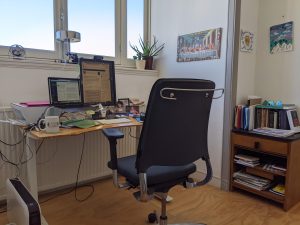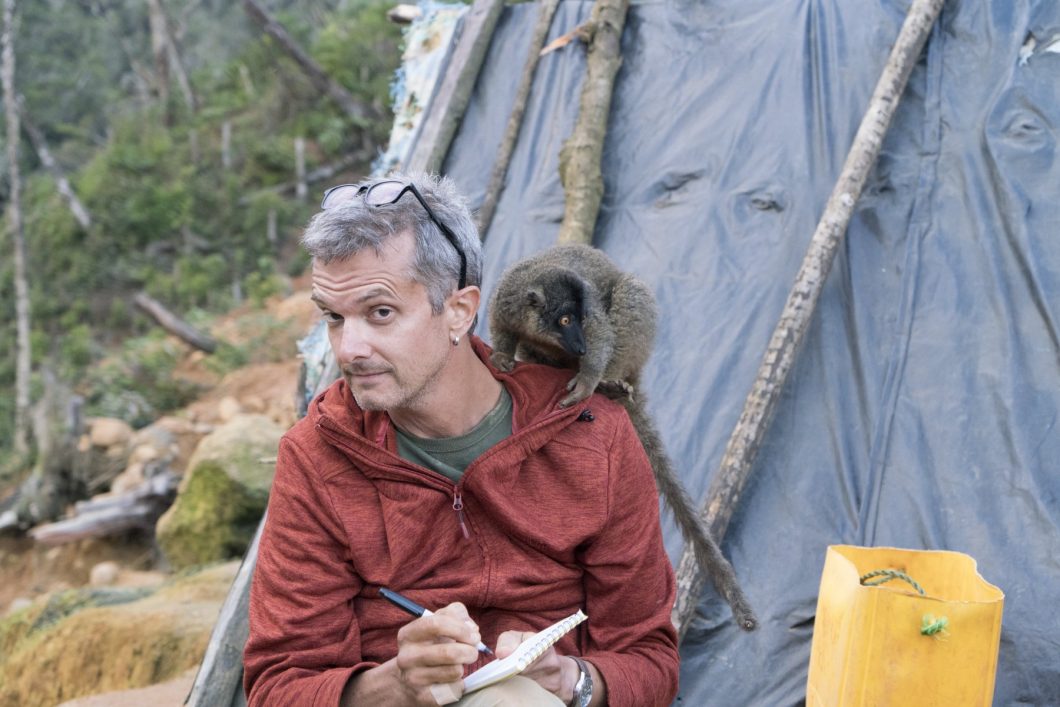
What I’m working on:
My strategy is to be pitching a story, reporting a story, writing a story, revising a story, and closing a story at the same time, all the time. It keeps the income flow regular. If any of the buckets are empty, the only solution is obviously to pitch more. So right now I have three pitches out, I’m working on two more, I’m reporting a story for NYT, writing a 1200-word piece for Businessweek, revising a feature for Town & Country, and waiting for copyedits on a big explanatory feature for Hakai Magazine.
Where I work:
I moved to Amsterdam in 2019, which was one of the best decisions I have ever made. Life in Europe is immeasurably more chill (average work week is 27 hours compared to 34 in the U.S.), and it’s amazing what a society can be when it has an adequately funded and appropriately staffed government. Everyone should move here. (If you can keep €4,500 in the bank and earn €38,000 a year and you’re a U.S. citizen, you can get a visa to live in the Netherlands for two years, renewable for five years after that, during which you can apply for permanent residency or citizenship.) Childcare is subsidized, we get about €100 per child every month from the government, the city of Amsterdam will pay for your child’s music or dance or art lessons if you qualify, health insurance for all four of us including dental is €267/month with zero copays and a €750 deductible, our cell phone bill is 80 percent less than it was in the U.S., groceries are cheaper, we don’t need a car, workers get four months of paid family leave by EU law, and five weeks of annual vacation is standard. College costs €2,200 a year. We pay 38 percent tax on 70 percent of our income for the first five years. I mean, seriously. (Anyone who wants advice on how to move here is welcome to get in touch via my website or Twitter.)
I rent a small office in a monument building in the canal ring, a seven-minute bike ride from our apartment, with a view of a 17th-century church. I have a convertible standing desk, a convertible (portrait/landscape) monitor, a rack for my laptop, a cheap printer, and an ergonomic wireless mouse. It’s a pretty good setup.
Daily routine:

I get up at 7:00 most days to help get the kids out the door for school; one of them is at the National Ballet Academy where she dances literally four to six hours a day so my partner feels it is important to oversee her nutrition intake and I support that by dragging my ass out of bed with them even though I don’t really have to be anywhere usually until at least 9:00. Coffee (decaf), a glass of Athletic Greens, which means I don’t have to think about my diet for the rest of the day except my protein intake (I’m vegetarian, and not young, so I lose muscle mass if I don’t get around 100 g/day and do some resistance training), maybe make breakfast for someone, walk the dogs for 30–45 minutes. If I work out, which I try to do two to four times a week when my back is not experiencing its periodic stiffness and I have slept decently (see below), it has to be now. When viral presence in my community is low, I go to the gym a block away; when it’s high, I use a set of weights at home or run 3–5 km. Then breakfast, shower if I worked out, and I get to the office around 10:00 or 11:00. My MO is to do the one essential thing that needs to be done that day first. Sometimes there is no essential thing that needs doing that day, so I run through whatever emails I can dispose of quickly, check Twitter, FB, and LinkedIn (15 minutes max), scan the headlines at The New York Times and NRC.nl, Pocket whatever will take longer than five minutes to read and isn’t essential to my current assignments/pitches, then I look at my project spreadsheet and see what needs doing, and do them. I leave the office by 7:30 unless I have a call with the West Coast. This Monday I left at 11:30 p.m., Tuesday at 8:45 p.m. But that’s rare.
Most productive part of my day:
8:00–1:00 and 4:00–9:00 p.m.
Most essential ritual or habit:
My partner and I take time for each other. Date night has been sporadic with restaurant closures, but every month or so we go on a “day date” to discover some part of the city we haven’t seen, or return to a favorite spot. Apart from the emotional support she offers, she is smarter and more educated than me, and a voracious reader of news, so always good to bounce ideas off of, and has greater interpersonal intelligence than I do, so helps me deal with the mysterious ways of editors.
Less romantically: naps. I am a member of the Arianna Huffington school of nap promotion. (My partner was once asked to name one thing I’m better at than her. Her answer: “Napping.”) When I’m not in the field I usually lie down after lunch for 30 minutes. Even 10 minutes of actual sleep revives me for several hours of productive work.
I learned to meditate about 15 years ago from a guy who learned from a guy who learned from the guy who taught The Beatles, and while I can’t say whether or not it’s made me a more calm or productive person or made me one with the universe, I figure it’s a better way to procrastinate than playing fucking Spelling Bee, which I detest because I am terrible at it.
Favorite note-taking techniques/tools:

Zoom’s pandemic takeover has changed how I take notes. Before, I’d not record unless it was a sensitive interview and I wanted to make sure I had the person on tape saying what I was gonna say they said. Otherwise I’d spend time listening to the interview again which seemed like a waste. So I’d be frantically typing the whole time, trying to get every word the subject said (using a personal shorthand, lots of keyboard shortcuts which is a huge time saver, and with many typos). But that meant I wasn’t really listening. Now I just record everything on Zoom and listen, and only type in stuff that seems important or that I want to go back to. These recordings go to Otter, which is good enough for $100/yr., but I’d never trust it for a quotation I’m planning to use—always check the recording! Also, it doesn’t know the difference between things like “5 to 10 years, no sooner,” and “5 to 10 years—no, sooner.” (Also the company will turn over your recordings to law enforcement, so don’t use it for sources whom you are obligated to protect.) I feel badly for the woman I used to hire to transcribe some interviews, but then some of my clients are paying me less than what I was making in 1995, so we’re in the same boat.
I like those old-style reporter’s notebooks with the spiral binding at the top, but they’re not easy to find. When in the field I always bring a Rite in the Rain notebook and pen. This has saved me many times.
How I keep track of my to-do list:
Productivity wizard that I am, I have an Evernote note called “to-do list.” I also keep a spreadsheet of all my projects and putative projects (more on this below), which is color coded so I can quickly see what I need to do.
Essential software/apps/productivity tools:

I started using Evernote more than a decade ago and was one of those crazy evangelists. It has pretty much replaced my OS. Everything goes in Evernote, from my kids’ vaccination records to story ideas, PDFs of studies, interview notes and recordings. It can read handwriting and has a good web clipper for desktop and mobile. I’ve considered Notion and other stuff but I’m not sure my Evernote archive (currently at 7,219 notes) would transfer correctly (or at all) so despite its having deteriorated somewhat in quality and features in recent years I think I’m gonna stick with it.
I use a spreadsheet of my own design to track projects and my hours. I divide projects into pitching, reporting, logistics (stuff like travel planning and invoicing for expenses), travel, writing, follow-up reporting, revising, and closing, and figure out how long I can spend on each part based on what I’m getting paid (here’s the template—note the comments by rolling over the yellow triangles). Coincidentally, it includes elements of another freelancer spreadsheet, which I read about in an earlier Day in the Life. Anyway, the total time spent is based on what I need to earn hourly to meet my family budget. The point being so I don’t end up working for $15/hr. because I over-report something or torture myself over two sentences in the lede. If I’m getting close to the limit of any stage in the process, I need to wrap up that portion or reallocate. I almost always get within 10 percent of my target hourly rate, and I more often exceed it than fall short. That said, there’s a lot of time that goes unremunerated—admin, pitches that don’t sell, looking for story ideas, self-promotion, professional development.
I used that Self Journal for a while when I was working mainly on just one big, long-term project, but for multiple projects of varying demands I find it’s not flexible enough.
Favorite time waster/procrastination habit:
Procrastinate productively. When I’m trying to avoid something, it’s not that I’d rather go see a movie or hang out in a dive bar all afternoon playing pool (although that does sound appealing—see you later!) Okay, I’m back. It’s usually that there’s just some particular thing I’m avoiding, either because it’s difficult or boring or I’m worried it’s not going to turn out the way I want. In the latter instance, procrastinating can actually be useful because if you spend some time mulling over the problem a solution might appear to you while you’re in the shower or cooking dinner or something. In the former instances, I avoid that thing by doing other stuff that doesn’t really need to get done but might pay off in some way, such as browsing my Evernote “story ideas” tag or the volumes of newsletters I subscribe to but never have time to read. Or doing this.

My reading habits:
A novel, almost every night before bed. It takes me out of my work headspace and is therefore crucially soporific—I have wasted probably months of my life tossing and turning in bed at night worrying about work and money, but not since I started this habit. Sometimes I read history; I don’t read much current-affairs nonfiction because I’m either editing it in my head as I go, or getting pissed at myself that I didn’t write it, and when it’s really good I just get mad that I will never write anything as good. (Yes, I recognize that this is symptomatic of a troubling sickness.) When I walk the dogs in the morning I listen to history audiobooks and podcasts. (Mark Maron, Broken Record, Song Exploder, 99% Invisible, the great stuff Josh Dean and colleagues are doing over at Campside Media. Floodlines and Lost Hills were great.)
Sleep schedule:
I’m usually in bed by 12:00 and up at 7:00. Once I had kids I realized I could get by on a lot less sleep than I had been. Seven hours and I’m good to workout + work a full day; six hours and I can function. I catch up with an extra hour on weekends, but staying up late and sleeping late on weekends has the same effect on your body as flying coast-to-coast, so it makes no sense if you expect to wake up fresh on Monday.


